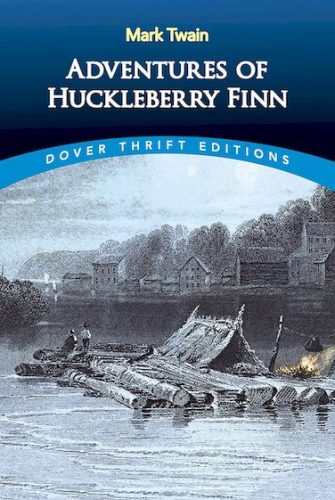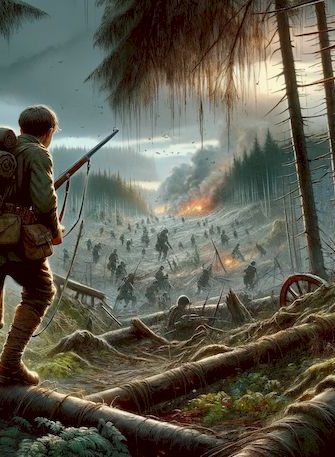Tom Sawyer is one of the most famous rascals in literature — and his creator, Mark Twain, was probably just such a rascal, for according to the author, Tom Sawyer’s hair-raising adventures are based on his childhood memories. Only specialists can tell what fiction is and what truth is. For the rest of us, childhood has never before and rarely since been written about in such a light-hearted and exciting way as in Mark Twain’s novel. The author skillfully weaves several episodes into one big whole: Tom has the neighbourhood boys do his annoying yard work for him, attends his funeral, explores a mysterious cave with his friend Becky, and finds himself in mortal danger several times with Huckleberry Finn. The novel was an excellent success for Twain, surpassed only by its more severe successor, The Adventures of Huckleberry Finn.

- Take Aways
- Tom Sawyer Summary
- Sweet Punishment
- Sunday School
- Tom and Becky
- The Murder in the Graveyard
- Tom Becomes a Pirate
- Tom and Huck as Treasure Diggers
- Huck as a Hero
- In the Cave
- The Treasure
- Huck Becomes Civilized
- About the Text
- Interpretation
- Historical Background
- Origins
- History of Impact
- About the Author
Take Aways
- In 1876, American author Mark Twain published one of his most famous and popular novels, The Adventures of Tom Sawyer.
- The story takes place in the fictional southern town of St. Petersburg on the Mississippi River.
- Tom Sawyer is an orphan who lives with his Aunt Polly, and his best friend is Huckleberry Finn.
- Tom likes to skip school and is a highly clever rascal.
- - He even knows how to “delegate” a chore to other boys and get rewarded for it.
- Tom also manages to exchange all sorts of odds and ends for certificates of achievement, making him the only one to receive a commendation from the perplexed teacher.
- One night, Tom and Huck watch Indian Joe murder with a friend.
- Tom falls in love with Becky Thatcher, who is new in town. He explores a mysterious cave with her, the exit they miss by a hair’s breadth.
- Huck saves the life of the widow Douglas by thwarting Indian Joe’s burglary attempt. She is so grateful that she adopts him.
- But the stray Huck doesn’t like civilized life, and it takes Tom to persuade him to stick around.
- In the end, Huck and Tom find a treasure and become filthy rich; Indian Joe dies in the cave.
- The adventures of Tom Sawyer were so popular that several pirate editions were immediately published, much to the chagrin of the beleaguered author.
Tom Sawyer Summary
Sweet Punishment
Orphan Tom Sawyer lives with his half-brother Sid at Aunt Polly’s in the small town of St. Petersburg on the Mississippi River. Unlike the obedient Sid, Tom is an authentic loafer who keeps escaping Aunt Polly. One hot afternoon, he skips school to go swimming. Aunt Polly comes up with an appropriate punishment. Instead of playing with the other boys on Saturday, Tom has to paint the garden fence. He sets to work with a heavy heart. The wall is ten feet high and thirty feet long, which is what he could have done that day!
To make matters worse, Ben Rogers arrives, a boy guaranteed to make fun of him. But Tom keeps his cool. He is so busy painting that he barely notices Ben, and he devotes himself to his work with such dedication that Ben is finally convinced that painting the fence must be a pleasure. He asks Tom to give it a try. Tom is reluctant, however, and only lets him try when Ben gives him an apple. He does the same with other boys who come along and soon have a dead rat, a dragon, an old window frame, twelve marbles, and many other great things. The fence is also painted, and Aunt Polly praises her foster son for his hard work.
Sunday School
Before Sunday school, Tom struggles to memorize his Bible verses. Meanwhile, his cousin Mary worries about his appearance and gives him a tin bowl of water and a bar of soap to wash himself. Tom moistens the soap, pours the water, and wipes his face with a towel. Mary notices the trick and takes matters into her own hands. She buttons his jacket, puts a collar and a silly straw hat on his head, and even forces him to wear greased shoes. Disgruntled, Tom goes to Sunday school all dressed up. At the door, he begins a lively barter: he trades a piece of liquorice and a fishhook for a yellow slip of paper from Ben, representing a commendation from the school. Hardly anyone in the class can recite his lesson, but with a lot of whispering and pretending, the students finally manage to do so, and each receives a blue slip in return. For ten blue slips, you get a red one; for ten red ones, you get a yellow one; and for ten yellow slips, you are ceremoniously presented with a Bible. Today’s service is interrupted by new citizens’ arrival: Attorney Thatcher and his family, including his lovely daughter Becky. It’s a good thing Tom has ten yellow slips today! To the teacher’s amazement, he shows them off to everyone, receives the Bible, and makes quite an impression on Becky.
Tom and Becky
On his way to school on Monday, Tom meets Huckleberry Finn, a stray who never goes to school and lives in a barrel. Huck wears long men’s clothes that flap around him and are a terror to the adults in the village. But he is well received by the boys. Tom makes a date with him for the night. When the teacher asks him why he is late for school, he boldly replies that he has been chatting with Huck. His punishment is to sit on the girls’ side. He sits next to Becky. At first, she moves away from him, but Tom quickly gets her attention by making drawings on his blackboard. Finally, he writes, “I love you”, and Becky is flattered. During recess, Tom suggests to Becky that they get engaged. She must tell him that she loves him too. He kisses her, and they promise never to marry anyone else. But then Tom makes an embarrassing mistake: he explains that engagement is lovely because he has already experienced it with Amy Lawrence. Becky is immediately furious and jealous. She doesn’t want to talk to him anymore. Tom can’t change her mind and runs out of the school.
The Murder in the Graveyard
Tom lies in his bed, waiting for Huck to meow outside his window at midnight. The hours pass slowly, and the noises become more and more eerie. Finally, Huck arrives, and Tom quickly climbs out the window. Huck is already downstairs with a dead cat. Together, they walk to the graveyard. The graves are all sunk in; instead of headstones, there are only weathered wooden crosses. The boys go to the grave of Ross Williams, who had recently died. Here, they plan an adventurous action: they want to wait until the devil comes for the dead man, then throw the cat after him and say a spell to get rid of his warts. They feel very uneasy about this. They hear voices and think the spirits are coming to get them. But then they realize that the voices are coming from people made of flesh and blood. Anxiously hiding behind elms, they watch as the dreaded Indian Joe, the drunkard Muff Potter, and the town doctor open a grave and steal the body. They argue about payment, and Potter and the doctor come to blows. When Potter is hit and falls to the ground, Indian Joe grabs his knife and plunges it into the doctor’s chest. As the doctor breathes his last, Indian Joe puts the knife in Potter’s hand. The doctor regains consciousness, and Joe tells him that he is the murderer. But he assures him that he will not betray him. Shocked, the boys run away and make a blood oath: they will never speak of this.
Tom Becomes a Pirate
Soon after, the murder is discovered. Muff Potter is put behind bars. At school, Tom continues to be ignored by Becky. Sadly, he decides to disappear and become a pirate. With Joe Harper, who his mother beat for something he didn’t do, and Huck, Tom leaves at midnight. The three steal a raft and row to a wooded island in the Mississippi River with some stolen supplies. They set up camp in the deep woods. They light a fire and roast the bacon they brought with them. Freedom tastes wonderful! For breakfast, they catch and fry some fish. Then they swim, explore the forest, and learn how to smoke from Huck. At first, Tom and Joe feel nauseous, but the second time they smoke, it works well. In the afternoon, they hear a loud banging: they see a steamboat, apparently looking for drowned people in the river. Gradually, the boys realize that it is them. Tom sneaks into Aunt Polly’s house at night and hears her mourn for him. The next day, he tells his fellow pirates that a funeral is being planned for her. Overjoyed, the boys hide in the church and suddenly find themselves before the mourners. Aunt Polly and Joe Harper’s mother are overjoyed to have the children back. They are hailed as heroes in the small town.
Tom and Huck as Treasure Diggers
One day, Tom and Huck decide to dig for a hidden treasure. While Huck wants to get his share immediately and buy cake and soda daily, Tom wants to get married. After digging in several places to no avail, Tom suggests they try the “haunted house”. The boys explore the house, leave their pickaxes in the basement, and climb to the attic. Suddenly, two men enter the house. One is a ragged journeyman the boys don’t know, and the other is Indian Joe. The men talk about a “thing” they shot and consider whether they should hide the money here in the haunted house. They decide against it and hide the loot in “number two where the cross is”. Then they leave the house. Tom and Huck excitedly discuss what “number two” might mean. Finally, they agree that it must be a room in an inn. Since there are only two inns in the village, Tom quickly finds out that room number two in one of the inns is occupied by a lawyer. However, room number two in the other inn is always dark, and someone only comes out at night. Using a bunch of stolen keys, Tom and Huck sneak into the dark inn at night. Huck keeps watch while Tom tries the keys. After what seems like an eternity, he emerges, pale with fright. Stammering reports that Indian Joe is asleep on the floor of the room and has almost stepped on his hand.
Huck as a Hero
During the following nights, Huck watches the back door of the inn. Eventually, he sees two figures coming out. He follows them to the Widow Douglas’s house and overhears an eerie conversation. Indian Joe and his companion are planning to rob the widow and mutilate her face. Distraught, Huck retreats and quickly runs to his neighbour. He listens to Huck’s story, arms himself and his two sons, and pursues the two criminals. A gunfight ensues, but the scoundrels manage to escape. When the widow hears about the planned robbery that Huck foiled, she is very grateful to the boy. Huck has a bad fever, and she nurses him back to health. But his main concern is still the treasure.
In the Cave
Tom has made up with Becky, taking the blame for a prank she played on the teacher. Becky invites her classmates to a picnic. Since it can get late, they arrange for Tom and Becky to spend the night with friends. The children run around and play hide-and-seek in the McDouglas cave. They know only a tiny part of the branching corridors. Tom doesn’t see the cave any better than the others, and after looking at the stalactites for a long time with Becky, they realize they can’t hear the other children. They run anxiously through the corridors, but Tom soon admits he can’t find the exit. They share the rest of the cake, and Becky cuddles up to Tom and cries. As the hours pass, Becky believes that death is near. Tom leaves her at a water source and explores more passages with the help of a kite string. Suddenly, he sees a human hand barely ten meters before him. Tom shouts joyfully, but then he sees who it belongs to: Indian Joe! The criminal is also startled and flees into the darkness while Tom returns to Becky. Soon, he starts another search and finally discovers a bit of daylight. Together with Becky, he squeezes through a narrow opening — they are saved. St. Petersburg is overjoyed to have the children back. The worried mayor has the entrance to the cave boarded up with strong boards so that no one can get lost there again. When Tom finds out two weeks later, he tells the adults that Indian Joe is still in the cave.
The Treasure
The cave opens immediately. Indian Joe is lying behind the boards — dead. Next to him is his knife, which broke off when he tried to cut through the boards. Tom tells Huck that the money was never in the inn but in the cave. So, Huck wants to go back to the cave with Tom. They borrow a boat and go there. Tom shows Huck the spot where he and Becky came out in the rock face. Now that they have such a tremendous secret entrance, he suggests forming a band of robbers. It would be even better than being pirates. The two enter the cave, and Tom quickly finds where he met Indian Joe. There are two carved into the cave wall under a cross. They see the entrance to a secret chasm when they dig under it. They have barely taken a few steps when they encounter a treasure chest. They quickly filled the bags they brought with them. When the money is later counted in the small town, the total is over $12,000.
Huck Becomes Civilized
The two newly rich boys are treated like heroes at a surprise party. The grateful widow Douglas takes Huck in and buys him good suits and shoes. But he doesn’t like civilized life at all: he has to get up early, eat at set times, and sleep in bedclothes so he can’t find a spot. He is not allowed to shout, swear, or smoke. In short, it could be more enjoyable. Becky’s father is very grateful to Tom for rescuing his daughter. He wants to use his connections to send Tom to the military academy. Tom himself sets up his band of robbers for the time being. When Huck leaves the widow after three weeks and returns to live in his barrel in rags, Tom seeks him out: Huck must go back, or he is an “indecent subject” who does not belong in his band of robbers. Huck complies and, from then on, accepts the tortures of civilized life to become a decent robber.
About the Text
As the title suggests, The Adventures of Tom Sawyer is a collection of sometimes turbulent episodes: Tom’s fence painting, the visit to his funeral, and the exploration of the cave all are memorable episodes, some of which have become known as individual stories. Most can be assigned to the plot complexes “Tom and Becky” and “Tom, Huck and Indian Joe”. The book serves several genres at once: it is a rogue’s story, but it also has the characteristics of a bildungsroman. Twain peppered it with satire that is usually understood only by adults, but at the same time, it is a book for young people. The narrator looks back on the events in the fictional city of St. Petersburg with a confident nostalgic wink: he reports in the past tense and knows more about the characters than they reveal in literal speech; he is, therefore, an omniscient narrator. Only in the sequel, Huckleberry Finn’s Adventures, did Twain find the original first-person narrative tone of his hero, Huck. A unique feature of Tom Sawyer’s Adventures is the brash Southern dialect in which Mark Twain wrote the story. Only a little of that remains in this German translation, but it is still a delightful read.
Interpretation
- The friends Tom Sawyer and Huckleberry Finn are in many ways opposites: The wandering Huck has a much more severe world of experience than the sheltered Tom. However, the latter’s imagination, drawn mainly from novels and adventure stories, strongly influences the comparatively naive Huck.
- Throughout the novel, Tom goes through several stages that make him seem more mature and adult by the end. In this respect, the book is also a coming-of-age novel. First come the mischievous pranks (e.g., the fencing episode), the grave, sometimes life-threatening confrontations with Indian Joe, and the cave experience.
- The cave is a classic symbol of the hero’s coming of age. Tom distances himself from his peers, experiences the adventure in the cave — and returns to the bosom of society in a mature state. His maturity is also demonstrated by the fact that he is the one who finally convinces Huck to give up his life as a drifter.
- The pattern of death and resurrection runs throughout the novel: bodies are dug up, Tom and Huck attend their funerals, and Tom and Becky are resurrected from the McDouglas cave.
- Many commentators consider the novel autobiographical. In fact, Twain himself points out in his preface that some of Tom’s adventures actually happened to him and that the two main characters are based on the memories of some of his comrades of his youth. Other characters are based on real people: the lawyer Thatcher is based on Twain’s father, Aunt Polly on his mother, and Becky on his first girlfriend.
Historical Background
Tom Sawyer’s adventure takes place in the fictional, quiet little southern town of St. Petersburg, on the Mississippi River in Missouri, around the middle of the 19th century. Twain based the city on his hometown of Hannibal. The French founded the first European settlement in what would become Missouri in 1735, and it was called Ste. Genevieve. Before that, the area was primarily inhabited by Native Americans from the Sioux and Algonquin tribes. St. Louis was founded in 1764. Missouri was sold to the Spanish but was returned to the French around 1800 and finally became the 24th state of the USA in 1821. The individual territories of the USA had joined together in 1781 to form a loose confederation of states under the Articles of Confederation. However, the agreement was not worth the paper it was written on, so the Constitutional Convention, chaired by George Washington, met and drafted the U.S. Constitution, which was finally ratified in 1789. Washington went on to become the first President of the United States. During this time, the two major political parties, the Federalists and the Democratic-Republicans, were formed. Washington’s successor, Thomas Jefferson, purchased land and pushed the boundaries of the former colonies westward (“pushing the frontier”). The first half of the 19th century saw the emergence of three distinct economic regions: the North, dominated by industry; the South, dominated by plantations; and the West, dominated by agriculture and ranching. As the economic regions also differed culturally and socially, the differences between the North and the South became so pronounced that the Civil War broke out in 1861 over the issue of slavery.
Origins
In 1861, at the beginning of the Civil War, Mark Twain enlisted as a volunteer in the Army of the South. But this military interlude in the cavalry was short-lived. Only a year later, he tried to launch a literary career. By the end of the 1860s, he had established himself as a writer, married into an influential New York family, and settled with his wife in Hartford, Connecticut. Here, Twain began work on The Adventures of Tom Sawyer, deliberately turning away from his earlier large-scale satirical writings to set down on paper the comparatively “small” adventures of his youthful hero. The book was written in three sections — the winter of 1872/73, the summer of 1874, and the spring/summer of 1875. Twain had initially planned to include Tom’s transformation from child to teenager to adult but abandoned that plan: Tom remains a boy until the end of the book, with the transition to the adult world yet to come. Twain drew ideas for creating the title character from his acquaintance with three boys from his childhood. The book was published on June 8, 1876 — but in England. The reason: Twain wanted to secure the English copyright for his novel.
History of Impact
“Although my book is primarily intended for the amusement of boys and girls, I hope that men and women will not avoid it for that reason,” Twain wrote in his preface to Tom Sawyer’s Adventures. That faint hope was soon more than surpassed by reality — albeit in a very different way than Twain had imagined. The book was a massive success in England, and even before the American edition was published, it was hijacked by a Canadian pirate press. The pirated copies soon reached the United States. Twain was furious, and it was not until four months after the bootlegging that his publisher released the authorized and illustrated American edition. By this time, the author had already lost, by his reckoning, some $10,000 — an impressive illustration of the story’s immense popularity. Twain was so depressed by the financial disaster that he did not touch a pen for several years. When he finally published Huckleberry Finn’s Adventures in 1885, it was subtitled “Tom Sawyer’s Companion,” which also boosted sales of the earlier book. Reviews of the novel appeared in all the major newspapers. A review of the English edition in the London Examiner with many excerpts from the book was reprinted by several American newspapers so that the novel and its characters were very familiar to the American public through this partial “preprint.
Not least because Tom Sawyer’s adventures still echo the American dream in such a childlike and naïve way, the popularity of the Southern boy is unbroken to this day; he is practically the archetype of the rascal.
About the Author
Mark Twain, the pen name of Samuel Langhorne Clemens, was an iconic American author born on November 30, 1835, in Florida, Missouri. His childhood in Hannibal, a quaint town on the Mississippi River, profoundly influenced his most celebrated characters, Tom Sawyer and Huckleberry Finn. Twain embarked on a diverse career path, from typesetting to piloting a Mississippi steamboat, from which he took his famous pseudonym. His varied experiences enriched his writing, leading to classics like “The Adventures of Tom Sawyer” and “Adventures of Huckleberry Finn.” Twain’s literary journey was marked by humour, social critique, and the exploration of human nature. Despite financial hardships and personal tragedies, Twain’s work remained beloved worldwide. He died on April 21, 1910, in Redding, Connecticut, leaving a lasting legacy in American literature.



